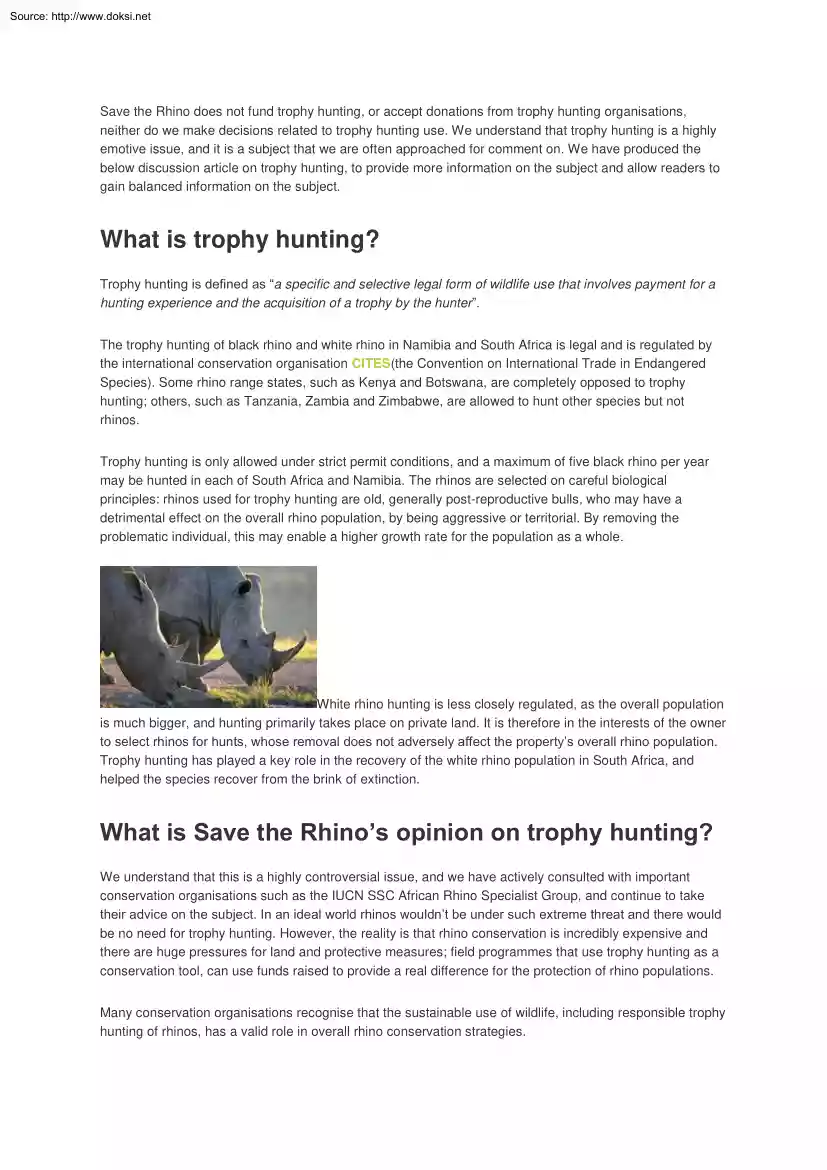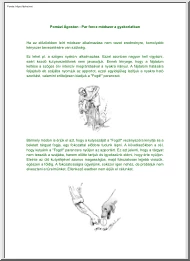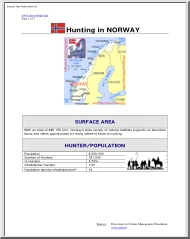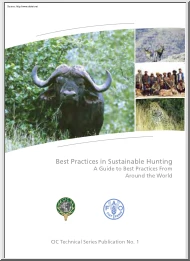Datasheet
Year, pagecount:2014, 4 page(s)
Language:English
Downloads:2
Uploaded:March 07, 2019
Size:672 KB
Institution:
-
Comments:
Attachment:-
Download in PDF:Please log in!
Comments
No comments yet. You can be the first!Content extract
Source: http://www.doksinet Save the Rhino does not fund trophy hunting, or accept donations from trophy hunting organisations, neither do we make decisions related to trophy hunting use. We understand that trophy hunting is a highly emotive issue, and it is a subject that we are often approached for comment on. We have produced the below discussion article on trophy hunting, to provide more information on the subject and allow readers to gain balanced information on the subject. What is trophy hunting? Trophy hunting is defined as “a specific and selective legal form of wildlife use that involves payment for a hunting experience and the acquisition of a trophy by the hunter”. The trophy hunting of black rhino and white rhino in Namibia and South Africa is legal and is regulated by the international conservation organisation CITES(the Convention on International Trade in Endangered Species). Some rhino range states, such as Kenya and Botswana, are completely opposed to trophy
hunting; others, such as Tanzania, Zambia and Zimbabwe, are allowed to hunt other species but not rhinos. Trophy hunting is only allowed under strict permit conditions, and a maximum of five black rhino per year may be hunted in each of South Africa and Namibia. The rhinos are selected on careful biological principles: rhinos used for trophy hunting are old, generally post-reproductive bulls, who may have a detrimental effect on the overall rhino population, by being aggressive or territorial. By removing the problematic individual, this may enable a higher growth rate for the population as a whole. White rhino hunting is less closely regulated, as the overall population is much bigger, and hunting primarily takes place on private land. It is therefore in the interests of the owner to select rhinos for hunts, whose removal does not adversely affect the property’s overall rhino population. Trophy hunting has played a key role in the recovery of the white rhino population in South
Africa, and helped the species recover from the brink of extinction. What is Save the Rhino’s opinion on trophy hunting? We understand that this is a highly controversial issue, and we have actively consulted with important conservation organisations such as the IUCN SSC African Rhino Specialist Group, and continue to take their advice on the subject. In an ideal world rhinos wouldn’t be under such extreme threat and there would be no need for trophy hunting. However, the reality is that rhino conservation is incredibly expensive and there are huge pressures for land and protective measures; field programmes that use trophy hunting as a conservation tool, can use funds raised to provide a real difference for the protection of rhino populations. Many conservation organisations recognise that the sustainable use of wildlife, including responsible trophy hunting of rhinos, has a valid role in overall rhino conservation strategies. Source: http://www.doksinet How does trophy
hunting benefit rhino conservation? There is enormous pressure on land and wildlife from expanding human populations. Land owners need to get a benefit from having wildlife on their land otherwise the land is often used for agriculture or built upon leaving very little space for wildlife to live. Income may come from tourism but this is not always an option At the turn of the century, only around 50-100 white rhino remained in South Africa and urgent conservation action, including the involvement of private landowners, was taken to save this species from the brink of extinction. Since 1968, South Africa has permitted the limited hunting of Southern white rhino and data from the IUCN African Rhino Specialist Group shows that since hunting began, the numbers of Southern white rhino have increased from 1,800 to over 20,000. By allowing private landowners to conduct limited trophy hunting of rhinos, this helped give white rhinos an economic value and allowed private landowners and
communities to benefit from having rhinos on their land. It became an incentive to own rhinos Currently almost 25% of Africa’s rhinos are privately owned. Many National Parks have reached their carrying capacity for rhino populations. Private landowners and community land are important in providing habitat space to host and expand rhino populations. To do this, they need to receive income and derive a benefit from having wildlife on their land. The current rhino poaching crisis is rapidly escalating, with over 946 rhinos killed in South Africa in 2013 as at 19 December. The increasingly high prices fetched for rhino horn on the black market mean that ruthless criminal syndicates are heavily involved in rhino poaching. Unfortunately, this means that it is becoming increasingly expensive for both state and private landowners to protect their rhinos from poaching; huge sums of money are needed for intensive anti-poaching and monitoring patrols, including ranger salaries, technology such
as micro-chips and drones and transport such as helicopters and vehicles. In fact, several private landowners in South Africa are considering disinvesting in rhinos, as they can no longer afford the cost of protecting them. Which rhino species can be trophy hunted? White rhino are the most numerous of the five rhino species, and can be hunted in South Africa and Namibia. In 2004, the 13th Conference of the Parties (CoP13) of CITES approved quota applications by Namibia and South Africa each to sport hunt a maximum of five surplus male black rhinos per year. No hunting is allowed of Greater one-horned rhinos, Sumatran or Javan rhinos. Why can’t the money be raised in other ways? Source: http://www.doksinet Well yes, it would be nice if donors gave enough money to cover the spiralling costs of protecting rhinos from poachers. Or if enough photographic tourists visited parks and reserves to cover all the costs of community outreach and education programmes. Unfortunately, income
from tourism and public donations does not provide enough money to protect and grow rhino populations. Tourism can be fickle and therefore an unreliable source of income. For example trophy hunting provided an important source of conservation income for Zimbabwe, during the recent political turmoil, when visitor numbers dramatically declined. According to the IUCN successful tourism relies on a high level of capacity, capital, infrastructure, large wildlife populations, political stability and a scenic environment – all of which may be lacking; and it generally generates considerably greater environmental impact (through roads and infrastructure, water use, rubbish generation etc) than limited, carefully managed hunting. Benefits for the local community In several areas, local community conservancies help protect rhinos on their communal lands. They need to see a monetary benefit from having rhinos and other wildlife; otherwise the land will be converted to other purposes such as
farming. Funds from trophy hunting on communal lands provide an important source of income for community payments and other schemes. In recent decades, Namibia has pioneered the way for successful community-based resource management, allowing local communities to become directly involved in wildlife conservation. In 1997 the Namibian government established the Game Products Trust Fund (GPTF), to channel revenue from wildlife utilisation into conservation. The GPTF is about 70-80% money accrued out of utilisation, including money from rhino trophy hunting, tourism and hunting concessions. The Fund makes grants to a range of organisations, including conservancies, wildlife charities, and the Ministry of Environment and Tourism (MET), for use in wildlife conservation, with a particular emphasis on improving the relationship between people and wildlife. Click here to read an article by Ann & Steve Toon, who interviewed Pierre du Preez, the national rhino coordinator for the Namibian
MET, for more information on the role on the importance of sustainable wildlife utilization. Permit abuses The trophy hunting system is not without its faults and it is crucial that CITES keeps a close eye on how these quotas are policed, and makes sure any infringements are dealt with by criminal courts in the countries concerned. Over the past few years, it emerged that Vietnamese criminal gangs were taking advantage of South Africa’s legal loopholes in trophy hunting, by recruiting individuals with no hunting background to pose as trophy hunters. The proxy hunters then bring back the legally obtained rhino horn to Vietnam where it is then destined to illegal markets. Overall Vietnamese citizens have hunted more than 400 rhino legally on privately-owned properties in South Africa since 2003. In April 2012, South Africa formally suspended the issue of hunting permits to Vietnamese citizens, which has led to a marked decline in rhino hunting applications from South-East Asian
citizens. Some have argued that – given the high numbers of rhinos being poached every year in South Africa – trophy hunting should be suspended, in order to prevent further (legal) depletion of overall rhino numbers. Source: http://www.doksinet We believe that this will worsen the problem, as private rhino owners lose a major source of incomegeneration, while protection costs increase, and believe that this will lead to disinvestment in rhinos, resulting in a reduction of land available for rhino conservation. For more detailed comment on whether to put in place a moratorium on trophy hunting, please see this link: http://www.peace-of-edencoza/blog/wp-content/uploads/2012/01/Rhino-hunting-moratoriumpdf Conclusion There is no silver bullet to solve the current rhino poaching crisis and trophy hunting to raise income for rhino protection will not succeed on its own. Achieving the survival of the five rhino species will need a combination of approaches: increased security for
rhino populations; ensuring that local communities living in key rhino areas benefit from employment, education and training; proactive translocations to establish new breeding groups and maintain genetic diversity; building capacity in African and Asian countries so that conservation programmes are run efficiently and effectively; political pressure to enforce international agreements about wildlife trafficking; proper deterrent sentencing for those convicted of rhino poaching and horn smuggling; and demand-reduction programmes in user countries, primarily Vietnam and China. Further reading: Click here to read a comment from the IUCN African Rhino Specialist Group regarding the recent Dallas Safari Club black rhino permit auction Click here to read a comment from the IUCN Sustainable Livelihoods Specialist Group regarding the recent Dallas Safari Club black rhino permit auction Click here to read more about the recent Dallas Safari Club black rhino auction controversy
hunting; others, such as Tanzania, Zambia and Zimbabwe, are allowed to hunt other species but not rhinos. Trophy hunting is only allowed under strict permit conditions, and a maximum of five black rhino per year may be hunted in each of South Africa and Namibia. The rhinos are selected on careful biological principles: rhinos used for trophy hunting are old, generally post-reproductive bulls, who may have a detrimental effect on the overall rhino population, by being aggressive or territorial. By removing the problematic individual, this may enable a higher growth rate for the population as a whole. White rhino hunting is less closely regulated, as the overall population is much bigger, and hunting primarily takes place on private land. It is therefore in the interests of the owner to select rhinos for hunts, whose removal does not adversely affect the property’s overall rhino population. Trophy hunting has played a key role in the recovery of the white rhino population in South
Africa, and helped the species recover from the brink of extinction. What is Save the Rhino’s opinion on trophy hunting? We understand that this is a highly controversial issue, and we have actively consulted with important conservation organisations such as the IUCN SSC African Rhino Specialist Group, and continue to take their advice on the subject. In an ideal world rhinos wouldn’t be under such extreme threat and there would be no need for trophy hunting. However, the reality is that rhino conservation is incredibly expensive and there are huge pressures for land and protective measures; field programmes that use trophy hunting as a conservation tool, can use funds raised to provide a real difference for the protection of rhino populations. Many conservation organisations recognise that the sustainable use of wildlife, including responsible trophy hunting of rhinos, has a valid role in overall rhino conservation strategies. Source: http://www.doksinet How does trophy
hunting benefit rhino conservation? There is enormous pressure on land and wildlife from expanding human populations. Land owners need to get a benefit from having wildlife on their land otherwise the land is often used for agriculture or built upon leaving very little space for wildlife to live. Income may come from tourism but this is not always an option At the turn of the century, only around 50-100 white rhino remained in South Africa and urgent conservation action, including the involvement of private landowners, was taken to save this species from the brink of extinction. Since 1968, South Africa has permitted the limited hunting of Southern white rhino and data from the IUCN African Rhino Specialist Group shows that since hunting began, the numbers of Southern white rhino have increased from 1,800 to over 20,000. By allowing private landowners to conduct limited trophy hunting of rhinos, this helped give white rhinos an economic value and allowed private landowners and
communities to benefit from having rhinos on their land. It became an incentive to own rhinos Currently almost 25% of Africa’s rhinos are privately owned. Many National Parks have reached their carrying capacity for rhino populations. Private landowners and community land are important in providing habitat space to host and expand rhino populations. To do this, they need to receive income and derive a benefit from having wildlife on their land. The current rhino poaching crisis is rapidly escalating, with over 946 rhinos killed in South Africa in 2013 as at 19 December. The increasingly high prices fetched for rhino horn on the black market mean that ruthless criminal syndicates are heavily involved in rhino poaching. Unfortunately, this means that it is becoming increasingly expensive for both state and private landowners to protect their rhinos from poaching; huge sums of money are needed for intensive anti-poaching and monitoring patrols, including ranger salaries, technology such
as micro-chips and drones and transport such as helicopters and vehicles. In fact, several private landowners in South Africa are considering disinvesting in rhinos, as they can no longer afford the cost of protecting them. Which rhino species can be trophy hunted? White rhino are the most numerous of the five rhino species, and can be hunted in South Africa and Namibia. In 2004, the 13th Conference of the Parties (CoP13) of CITES approved quota applications by Namibia and South Africa each to sport hunt a maximum of five surplus male black rhinos per year. No hunting is allowed of Greater one-horned rhinos, Sumatran or Javan rhinos. Why can’t the money be raised in other ways? Source: http://www.doksinet Well yes, it would be nice if donors gave enough money to cover the spiralling costs of protecting rhinos from poachers. Or if enough photographic tourists visited parks and reserves to cover all the costs of community outreach and education programmes. Unfortunately, income
from tourism and public donations does not provide enough money to protect and grow rhino populations. Tourism can be fickle and therefore an unreliable source of income. For example trophy hunting provided an important source of conservation income for Zimbabwe, during the recent political turmoil, when visitor numbers dramatically declined. According to the IUCN successful tourism relies on a high level of capacity, capital, infrastructure, large wildlife populations, political stability and a scenic environment – all of which may be lacking; and it generally generates considerably greater environmental impact (through roads and infrastructure, water use, rubbish generation etc) than limited, carefully managed hunting. Benefits for the local community In several areas, local community conservancies help protect rhinos on their communal lands. They need to see a monetary benefit from having rhinos and other wildlife; otherwise the land will be converted to other purposes such as
farming. Funds from trophy hunting on communal lands provide an important source of income for community payments and other schemes. In recent decades, Namibia has pioneered the way for successful community-based resource management, allowing local communities to become directly involved in wildlife conservation. In 1997 the Namibian government established the Game Products Trust Fund (GPTF), to channel revenue from wildlife utilisation into conservation. The GPTF is about 70-80% money accrued out of utilisation, including money from rhino trophy hunting, tourism and hunting concessions. The Fund makes grants to a range of organisations, including conservancies, wildlife charities, and the Ministry of Environment and Tourism (MET), for use in wildlife conservation, with a particular emphasis on improving the relationship between people and wildlife. Click here to read an article by Ann & Steve Toon, who interviewed Pierre du Preez, the national rhino coordinator for the Namibian
MET, for more information on the role on the importance of sustainable wildlife utilization. Permit abuses The trophy hunting system is not without its faults and it is crucial that CITES keeps a close eye on how these quotas are policed, and makes sure any infringements are dealt with by criminal courts in the countries concerned. Over the past few years, it emerged that Vietnamese criminal gangs were taking advantage of South Africa’s legal loopholes in trophy hunting, by recruiting individuals with no hunting background to pose as trophy hunters. The proxy hunters then bring back the legally obtained rhino horn to Vietnam where it is then destined to illegal markets. Overall Vietnamese citizens have hunted more than 400 rhino legally on privately-owned properties in South Africa since 2003. In April 2012, South Africa formally suspended the issue of hunting permits to Vietnamese citizens, which has led to a marked decline in rhino hunting applications from South-East Asian
citizens. Some have argued that – given the high numbers of rhinos being poached every year in South Africa – trophy hunting should be suspended, in order to prevent further (legal) depletion of overall rhino numbers. Source: http://www.doksinet We believe that this will worsen the problem, as private rhino owners lose a major source of incomegeneration, while protection costs increase, and believe that this will lead to disinvestment in rhinos, resulting in a reduction of land available for rhino conservation. For more detailed comment on whether to put in place a moratorium on trophy hunting, please see this link: http://www.peace-of-edencoza/blog/wp-content/uploads/2012/01/Rhino-hunting-moratoriumpdf Conclusion There is no silver bullet to solve the current rhino poaching crisis and trophy hunting to raise income for rhino protection will not succeed on its own. Achieving the survival of the five rhino species will need a combination of approaches: increased security for
rhino populations; ensuring that local communities living in key rhino areas benefit from employment, education and training; proactive translocations to establish new breeding groups and maintain genetic diversity; building capacity in African and Asian countries so that conservation programmes are run efficiently and effectively; political pressure to enforce international agreements about wildlife trafficking; proper deterrent sentencing for those convicted of rhino poaching and horn smuggling; and demand-reduction programmes in user countries, primarily Vietnam and China. Further reading: Click here to read a comment from the IUCN African Rhino Specialist Group regarding the recent Dallas Safari Club black rhino permit auction Click here to read a comment from the IUCN Sustainable Livelihoods Specialist Group regarding the recent Dallas Safari Club black rhino permit auction Click here to read more about the recent Dallas Safari Club black rhino auction controversy





 Just like you draw up a plan when you’re going to war, building a house, or even going on vacation, you need to draw up a plan for your business. This tutorial will help you to clearly see where you are and make it possible to understand where you’re going.
Just like you draw up a plan when you’re going to war, building a house, or even going on vacation, you need to draw up a plan for your business. This tutorial will help you to clearly see where you are and make it possible to understand where you’re going.